

It will discuss the identity of their donors and will attempt to reconstruct the social, political as well as cultural role that each statuary group held in its given context.– Status: 100% ( 8/8 All chapters unlocked ) In order to do so, this paper will examine the sculptural assemblages of fountain structures in some of the major provincial cities of Greece (Argos, Athens, Nikopolis, Olympia, Corinth, Gortys). This paper discusses the presence and function of sculptures within the fountain structures and their use by the patrons of the monuments in order to project specific messages. As objects of private patronage they signaled the donor’s wealth, power and connection to the imperial regime. As an imperial benefaction, nymphaea proclaim the imperial power, virtue and culture.

Since monumental nymphaea were financed by emperors and wealthy patrons, financing the construction of a nymphaeum and (or) its decoration consists a politically motivated action. Different decorative programs reflected different purposes. iconographical programs, which differed among regions and among monuments. These sculptures adorned the monumental facades of roman nymphaea and deployed according to pre-scheduled. The study of fountain sculptures, that is sculptures with a visible water outlet ascertaining a spouting function or sculptures that regardless their function derive from a nymphaeum or an elaborated fountain, have only the past few years attracted the scholars' attention. It discusses the connection between the arena monuments (theatres, amphitheaters) as the symbol of Roman presence and power in the provinces, the Emperor as the image of the Imperium Romanum, and Nemesis, as an imperial ally that confirms, enforces and supports the imperial propaganda of the 2nd c. This paper is dealing with the presence of Nemesis’s cult in theatres and amphitheaters from the roman provinces of the Black Sea region, especially those from the western coast (Dacia, Thracia). AD and in the East and the Balkan-Danubian Provinces during the 2nd and 3rd c. These dedicatory inscriptions which reveal the relation between Nemesis' cult and the arena monuments are to be found in the West prior to the 2nd or 3rd c. The earlier testimonies regarding the association of Nemesis with gladiatorial games consist of votive inscriptions from theatres and amphitheaters.

Archaeology provides us with strong testimonies on the connection between Nemesis, spectacle monuments and the gladiatorial combats and beast-hunts held there. popularity during the roman period and late antiquity one of the most characteristic Nemesis features during the Imperial period is her intense presence in spectacle monuments throughout the Empire.

Starting as an abstract sense of the righteous anger, Nemesis soon developed to a powerful deity of the Graeco-Roman pantheon, while her cult gained a significant. AD at the provinces.Ģnd International Workshop on the Black Sea in Antiquity “The Black Sea in the light of new archaeological data and theoretical approaches” International Hellenic University, Thessaloniki, 18-20 September 2015 Starting as an abstract sense of the righteous anger, Nemesis soon developed to a powerful deity of the Graeco-Roman pantheon, while her cult gained a significant popularity during the roman period and late antiquity one of the most characteristic Nemesis features during the Imperial period is her intense presence in spectacle monuments throughout the Empire.


 0 kommentar(er)
0 kommentar(er)
